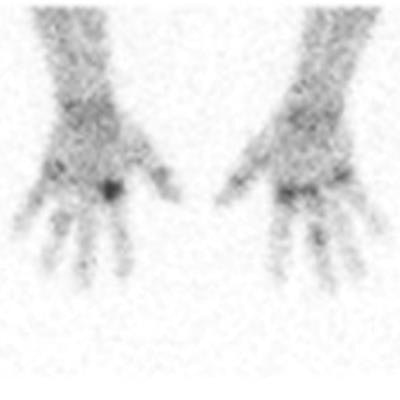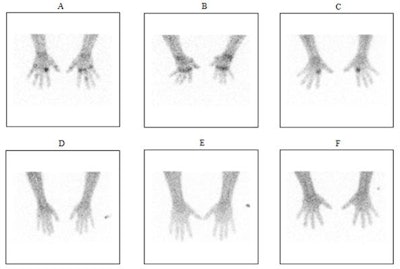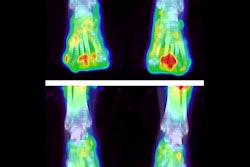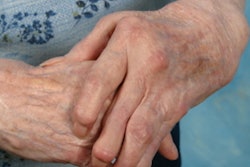
ANAHEIM, CA - New findings on a technetium-based radiopharmaceutical that could be useful for monitoring rheumatoid arthritis by tracking joint inflammation were presented on Sunday at the Society for Nuclear Medicine and Molecular Imaging (SNMMI) annual conference.
Rheumatoid arthritis affects over 1.3 million Americans every year, according to SNMMI. When it occurs in the synovial membrane in joints, macrophages are activated that release inflammatory-causing cytokines and chemokines.
But activated macrophages also highly express mannose receptor CD206, to which the radiotracer technetium-99m tilmanocept (TCT) binds -- making it a potential target for radiopharmaceuticals as a noninvasive biomarker for rheumatoid arthritis.
Previous research has shown subcutaneous administration of TCT to be safe and effective, so a research team led by Dr. Arash Kardan from Case Western Reserve University in Cleveland wanted to perform a phase I study of the radiotracer. They enrolled 39 individuals, 33 of whom had active arthritis and three who were healthy controls.
The subjects were divided into 11 groups and received combinations of intravenous Tc-99m TCT at 1 mCi, 5 mCi, and 10 mCi with 50 µg, 200 µg, or 400 µg of TCT. Imaging was then performed with a standard whole-body planar gamma camera, as well as spot views of the hand and wrists. Twelve of the subjects (six with rheumatoid arthritis and six healthy controls) also underwent whole-body planar scans for assessment of radiodosimetry and pharmacokinetics.
The planar scans revealed that TCT localizes in the inflamed joints of patients with rheumatoid arthritis but not in the joints of healthy controls. The study further indicated that the optimal dose was 134 µg of TCT and 10 mCi of Tc-99m, stable over an imaging period of one to three hours after injection. The researchers recommended this dose for further studies.
 A comparison of Tc-99m tilmanocept radiopharmaceutical uptake on planar imaging in subjects with active rheumatoid arthritis (A: 200 µg tilmanocept/10 mCi Tc-99m; B-C: 400 µg tilmanocept/10 mCi Tc-99m) versus healthy controls (D-F: 400 µg tilmanocept/10 mCi Tc-99m) at three hours post-IV administration. Image courtesy of Dr. Arash Kardan et al, University Hospitals/Case Western Reserve University, Cleveland, OH.
A comparison of Tc-99m tilmanocept radiopharmaceutical uptake on planar imaging in subjects with active rheumatoid arthritis (A: 200 µg tilmanocept/10 mCi Tc-99m; B-C: 400 µg tilmanocept/10 mCi Tc-99m) versus healthy controls (D-F: 400 µg tilmanocept/10 mCi Tc-99m) at three hours post-IV administration. Image courtesy of Dr. Arash Kardan et al, University Hospitals/Case Western Reserve University, Cleveland, OH.The data presented at SNMMI 2019 could form the basis for future clinical studies to assess if TCT imaging can give physicians a noninvasive way to home in on the receptors that indicate the presence and activity of rheumatoid arthritis, helping physicians develop the most appropriate treatment strategy.




















